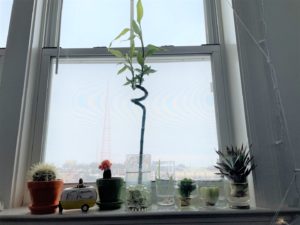By Mia Lukic
 Rising Gardens is a new program for the Women’s Center, and is a part of the One Billion Rising Movement. Rising Gardens aims to connect the power of a garden to a multitude of social issues. Encouraging people to grow gardens is not only a way to start a conversation about certain issues, but to combat them.
Rising Gardens is a new program for the Women’s Center, and is a part of the One Billion Rising Movement. Rising Gardens aims to connect the power of a garden to a multitude of social issues. Encouraging people to grow gardens is not only a way to start a conversation about certain issues, but to combat them.
“Gardens remind us of our enduring connection to life, to each other and to Earth, which compels us to do everything in our power to protect and nurture life and all that is sacred without doing harm. The cultivation of plant life is also a means for survival. Growing food in a garden organically – be it your own indoor garden or a community garden – allows you to feed yourself and your community. It provides autonomy and underscores the need for food security in a world where so many are denied these essential resources” (One Billion Rising).
Over the next three months we will highlight three major social issues and how they correlate to gardens, while growing our very own freedom gardens. Freedom gardens is a play on the term “victory gardens”, referring to gardens grown during World War II. The renaming comes from the association between victory gardens and anti-Asian sentiment, as a lot of Japansese-American farmland was seized by white farmers during this time (Freedom Gardens). Our freedom gardens will be grown in our homes, using household items and food scraps.
February is Black History Month and we are focusing on the connection between food and racial equity.
Leah Penniman is an amazing woman who founded Soul Fire Farm, a nonprofit organic farm devoted to training the new generation of farmers of color. She details why “food sovereignty is central in the fight for racial justice” in her book Farming While Black. A striking line from the book is spoken by a young black man stating “Look, you’re either going to die from the gun or you are going to die from bad food” (Penniman). Leah explains that a Black person in America is more likely to die from lack of access to good food than any type of violence, despite violence being the most covered by the media. “If you look at diabetes, kidney failure and heart disease—those are all inextricably linked to what types of food a person has access to. And the last time I looked, those are the leading causes of death”(Penniman). She says this by no means to diminish the murders of Black and Brown people, but rather to bring attention to both, and the connections between them.
Penniman also rejects the popular term “food desert” and instead prefers the term “food apartheid”, explaining that a desert is natural but nothing about what is happening in these scenarios is natural. Decades of redlining and zoning have made it harder for people of color to have access to certain neighborhoods and by default, quality food.
“The existence and persistence of community gardens in food deserts and low-income neighborhoods is a testament to the resilience of the Black and Brown communities who cultivate them” (One Billion Rising). Many people are trying to combat this inaccessibility with community gardens or personal gardens like freedom gardens.
My garden consists of spring onions, romaine lettuce, celery, and a pineapple. Some nonedible plants include three cacti (Spike, Pickle, and Sunny) and a bamboo aptly named Boo. (I figured it was cruel to name the plants I planned on eating soon). My spring onions are about two months old, and have been living and growing in my window since I purchased them at Walmart. They just keep regrowing their tops and getting cut as I need them. My celery and romaine lettuce are showing slow but steady growth and are only about a week old. Unfortunately, most likely due to the snow and freezing conditions my pineapple seems to be dying, I have moved it to the kitchen and there is little left to do but keep an eye on it. All of my plants are currently in jars I repurposed from anything like olives or even candles, and all of the plants themselves are just the roots of food I had purchased and normally would throw away. So far, this process has shown me how easy it is to repurpose food scraps and how not unlike flowers many vegetables are. We keep flowers in a vase without a second thought, why not celery? I have not bought spring onions in months, simply cutting what I need off the ones on my window sill. While I couldn’t feed myself entirely with my freedom garden, it is an easy way to keep vegetables and herbs in the house at all times. Once my lettuce and celery (hopefully) grow I will be able to make a small salad or snack with them and enjoy both the benefits of healthy food and the satisfaction of having grown something from seemingly nothing. I am very happy to see the greenery everyday if nothing else, they add life and color to every room. Check out our Instagram @umkcwomenc every Friday to watch their growth each week!
Sources:
https://www.onebillionrising.org/about/campaign/